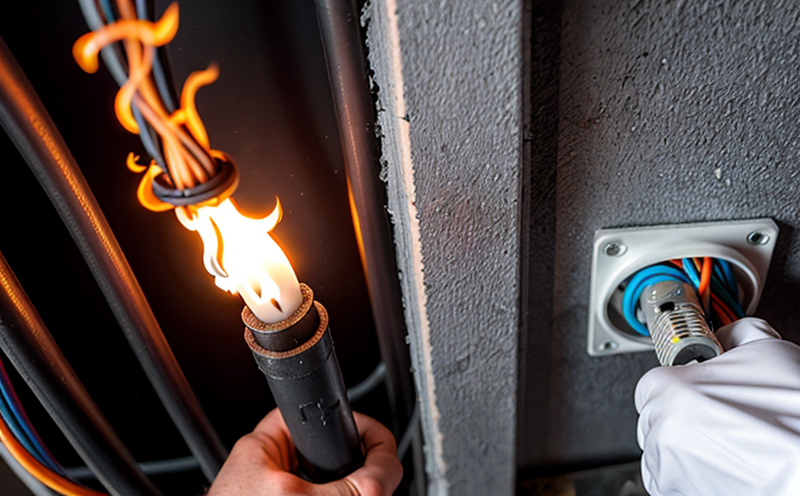Fire Resistance Testing of Coaxial Cables
The importance of fire resistance in coaxial cables cannot be overstated. In sectors such as aerospace, telecommunications, and building infrastructure, the integrity of wiring and cabling is paramount to ensure safety during fires or accidental ignition. Fire resistance testing ensures that these critical components meet stringent standards for reliability and performance under extreme conditions.
Coaxial cables are used in a wide range of applications where they need to transmit signals over long distances with minimal loss. They are integral parts of systems such as satellite communications, internet infrastructure, and building automation networks. The fire resistance testing process involves subjecting the cable assemblies to controlled environments that simulate real-world fire scenarios.
The test typically follows international standards like ISO 7253-1:2018 for electrical equipment and IEC 60811:2014 for power cables. The goal is to assess how well the cable insulation, jacketing, and other materials perform when exposed to high temperatures and flames. This includes evaluating the ability of the cable to maintain its structural integrity, prevent the spread of flame, and ensure that it does not contribute to a fire.
The testing process involves several key steps:
- Specimen Preparation: The cables are cut into standardized lengths and prepared for testing. This includes cleaning any external contamination and ensuring uniformity in sample preparation.
- Heating Chamber Setup: The samples are placed inside a controlled environment where they can be exposed to high temperatures and flames. These chambers simulate the conditions that cables might encounter during a fire event.
- Flame Exposure: Samples are subjected to specific flame durations and intensities as per the test protocol. This helps in assessing how quickly the cable ignites, burns, or extinguishes under controlled fire exposures.
- Data Collection: Throughout the testing process, various parameters such as flame spread rate, smoke density, heat release rates, and mass loss are recorded and analyzed.
- Post-Test Evaluation: After exposure to fire conditions, the cables undergo a thorough inspection. This includes checking for structural damage, changes in electrical properties, and residual materials that could pose risks.
| Parameter | Test Condition | Expected Outcome |
|---|---|---|
| Flame Spread Rate | Exposure to 500°C flame for 180 seconds | Less than 30 mm spread of flame |
| Smoke Density | Measurement at 2 meters from the sample | Below 50% according to EN 61748-2 |
| Heat Release Rate | During flame exposure | Less than 30 MJ/m² according to IEC 61252-19 |
The results of these tests provide critical insights into the fire resistance capabilities of coaxial cables. They help manufacturers and designers make informed decisions about material choices, manufacturing processes, and design optimizations to enhance safety in their products.
Customer Impact and Satisfaction
- Enhanced Safety: Products that pass fire resistance tests are safer, reducing the risk of fires and ensuring compliance with regulations.
- Informed Decision-Making: Fire resistance testing provides valuable data that helps customers choose products based on their specific needs and applications.
- Regulatory Compliance: Meeting fire resistance standards ensures that products comply with international regulations, paving the way for market entry in various countries.
Competitive Advantage and Market Impact
By incorporating rigorous fire resistance testing into their product development processes, manufacturers can gain a competitive edge. Products that are tested and certified as fire resistant not only meet regulatory requirements but also build trust with end-users. This leads to increased market share and customer loyalty.
Use Cases and Application Examples
- Aerospace: Ensuring that communication cables can withstand the harsh conditions of space travel.
- Telecommunications: Making sure that network infrastructure is robust enough to handle fires in data centers or other critical facilities.
- Building Infrastructure: Guaranteeing that building wiring systems are safe during emergencies like fires.





